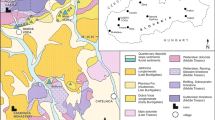Abstract
Extensive production of concrete and bricks has reduced the use of stone masonry in construction. The overwhelming use of artificial material, especially concrete, has led to many environmental issues. Use of dimension stone is almost non-existent in general construction. Nonetheless, it is still widely adopted in foundations, facings, dams, coastal defenses, and retaining and water containment structures. For the possible rational replacement of artificial materials, marble, schist, and granite were selected for evaluation as dimension stones. Important properties influencing the behaviour of construction material, such as compressive strength, tensile strength, durability, water absorption, and petrography, were investigated on selected rocks. The results were correlated with standard specifications of ASTM, ISO 14689-1 (Geotechnical investigation and testing. Identification and classification of rock. Part 1: Identification and description 1–16, 2003) and Gamble durability index (1971). Regional faults, Main Boundary Thrust, and Panjal Thrust, present in the area influence the characteristics of rocks adversely. Granite has a lower compressive strength than the ASTM specification so it should be avoided for load-bearing masonry units and external pavements. Granites and marbles have a higher degree of water absorption. All three rock units have a very high degree of polish, so their use as decorative stone, especially as internal flooring and at internal walls, is highly recommended.





















Similar content being viewed by others
References
Bell FG (2007) Geological materials used in construction. Engineering Geology, 2nd edn. Elsevier, Amsterdam, pp 278–288
Bieniawski ZT (1975) The point load test in Geotechnical practice. Eng Geol 9:1–11
Bossart P, Dietrich D, Greco A, Ottiger R, Ramsay JG (1984) A new structural interpretation of the Hazara Kashmir Syntaxis, southern Himalayas, Pakistan. Kashmir J Geol 2(1):19–36
Calkins JA, Matin ASA (2004) Geological map. Azad Kashmir (1962–64) Re-interpreted by Ahmed Hussain, Naseer Mughal, Ihteshamul Haq and Abdul Latif: Geological Survey of Pakistan
Gamble JC (1971) Durability-Plasticity classification of shales and other argillaceous rocks. Dissertation, University of Illinois
International Standard Organization (2003) 14689-1 (E) Geotechnical investigation and testing. Identification and classification of rock. Part 1: Identification and description. International organization for standardization, Geneva, pp 1–16
Khan MA, Khan MS (1989) Engineering characteristics of Nauseri Marble, Azad Kashmir. Kashmir J Geol 6 and 7: 125–132
Khan MA, Khan NA, Sheikh SA, Nasim S (1995) Geotechnical properties of Neelum granites, Neelum Valley, Azad Kashmir. Environ Eng Geosci 1(3):376–380 (Fall 1995)
Meyer C (2009) The greening of the concrete industry. Cem Concr Compos 31:601–605
Price DG (2009) Investigating the ground. Engineering Geology Principles and Practices (Edited and compiled by M.H de Freitas), pp 22–23
Quick GW (2002) CSIRO Building. Selective guide to the selection of dimension stone, Construction and Engineering, Highett, Victoria, Australia 3190: 01–03
Shah SMI (2009) Stratigraphy of Pakistan. GSP memoirs, Vol 22. Government of Pakistan, Ministry of Petroleum and Natural Resources, Pakistan
Sims I (1991) Quality and durability of stone for construction. Q J Eng Geol 24:67–74
Smith MR (ed) (1999) Stone: building stone, rock fill and armour stone in construction. Engineering Geology Special Publication No. 16, The Geological Society, London
Wadia DN (1934) The Cambrian-Trias sequence of Northwest Kashmir. Geol Surv India Rec 68 2:121–176
Author information
Authors and Affiliations
Corresponding author
Appendix
Appendix
See Tables 4, 5, 6, 7, 8, 9, and 10.
Rights and permissions
About this article
Cite this article
Mustafa, S., Khan, M.A., Khan, M.R. et al. Geotechnical study of marble, schist, and granite as dimension stone: a case study from parts of Lesser Himalaya, Neelum Valley Area, Azad Kashmir, Pakistan. Bull Eng Geol Environ 74, 1475–1487 (2015). https://doi.org/10.1007/s10064-015-0719-8
Received:
Accepted:
Published:
Issue Date:
DOI: https://doi.org/10.1007/s10064-015-0719-8




